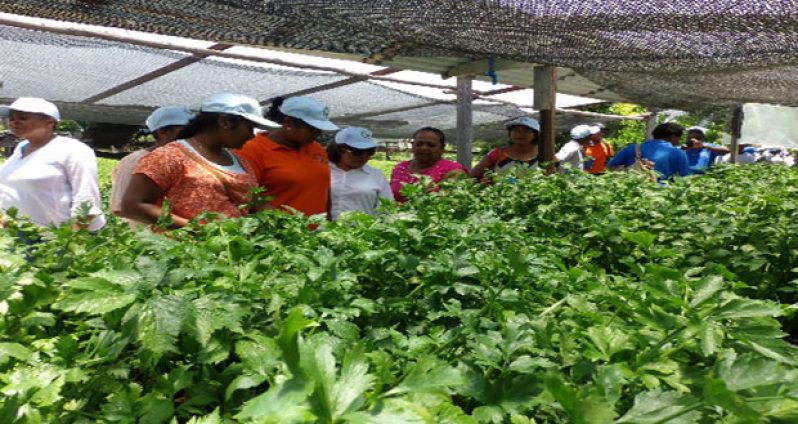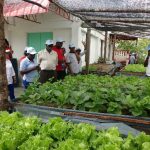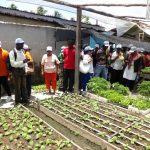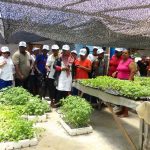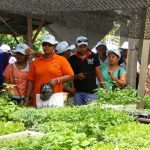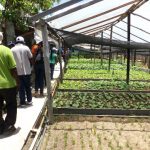THE Sustainable Livelihoods and Community Economic Growth through Hydroponics and Organic Vegetable Production and Marketing Project, had its first cluster exchange visit to Region 2 for 2015 a few weeks ago.This project is being implemented jointly by Partners of the Americas (Guyana Chapter) and Caribbean Self-Reliance International (CASRI).
Twenty eight shadehouse vegetable producers and two youths from an ongoing competition in Region 3 were able to benefit from this activity.
The group, which included shadehouse producers from Regions 3, 4, 5, 6 and 10 set out on this journey to the Cinderella County, some for the first time. They visited three shadehouses along the Essequibo Coast.
The first shadehouse visited was that owned by Mrs. Kemwattie Ramnarine, better known as Janet, of Perseverance. Janet’s farm spans 30 feet x 240 feet and she practises both hydroponics and organic/natural methods of planting.
At the time of the visit, she was growing crops such as celery, ginger, lettuce, pakchoy, tomato, pepper and callaloo (poi). She also has a nursery where she grows seedlings for herself and for sale. The group was certainly impressed by Janet’s garden and how organised and neat it was.
During a discussion with Janet for almost an hour, she highlighted that she finds the substrate paddy shell and sand to be the best to grow a wide range of crops hydroponically, even though she uses the floating- roots system to grow celery.
Janet was introduced to the hydroponic vegetable production system back in 2010/2011 during the Partners of the Americas first shadehouse project. It was a small area no more than 4` x 8.`
After seeing the difference in growth and quality, she gradually converted her entire yard to the shadehouse vegetable production system. Janet and her family now manage the largest shadehouse in Region 2.
The group then visited the International Society of Krishna Consciousness (ISKCON), where they met Mr. Raman, at Mainstay. This shadehouse was 28 feet x 30 feet and parsley, pakchoi, celery and tomatoes were being grown hydroponically.
Intrigue
At ISKCON, the group heard of how ISKCON started the shadehouse and the techniques used to monitor crops for pests. At this shadehouse, many of the visiting shadehouse vegetable producers from the regional cluster were intrigued by the way in which the tomatoes were grown.
ISKCON was obviously set for a bountiful harvest. In addition to the shadehouse, Mr. Raman showed the group more than 800 square feet of in-soil natural production of a range of vegetables, which included hot peppers, bajhi, cabbage, plantain and many more.
Mr. Raman explained that members of the Hare Khrisna group are strict vegetarians and the flooding of traditionally grown vegetables was a major problem. Hence, the importance of the shadehouse technology, using the raised beds. He was high in praise for the input of Partners of the Americas and has plans for a second shadehouse.
The third farm visited was one in Richmond owned by Mr. Hemchand Hemraj. This shadehouse was 12 feet x 24 feet. Mr. Hemraj showed off his lettuce, celery, eggplant (boulanger) and callaloo (poi) that were being grown hydroponically. However, in addition to this, Mr. Hemraj has at least another 300 square feet of his yard space devoted to natural in-soil and container gardening.
Creative cultivation
Among the containers used were television backs (castings of the old model televisions). Despite being the smallest shadehouse seen, the group commended Mr. Hemraj on his celery which was probably the best seen for the day. Everyone wanted to learn of his secret to producing callaloo with very big leaves. According to him, the method was quite simple, cutting off the tips of the plants to stop them from running and becoming stringy, forced the leaves to grow bigger and fuller. He also noted that paddy shell and sand was the best substrate to grow a range of vegetables hydroponically.
The event was therefore a huge success. Not only were the shadehouse vegetable producers able to network, but were able to see firsthand some of the best practices as they relate to hydroponic and organic/natural vegetable production.
They were able to learn of new techniques that they can put into use to aid their own production. The producers all spoke of the ease of growing vegetables using the hydroponics system, growing crops year-round under the shadehouse with no disturbance as a result of rain or flooding and better quality produce in high demand by consumers.
Several of them were already talking about expanding their own enterprises as a result of what they saw on the tour. The visiting shadehouse producers became enthused after the trip and they indicated their willingness to have a similar activity done in their regions. They threw out a challenge to Region 2 operators to “test them” in a few months. Persons in attendance exchanged contact numbers and promised to remain in contact for good reasons in the future.




.jpg)





